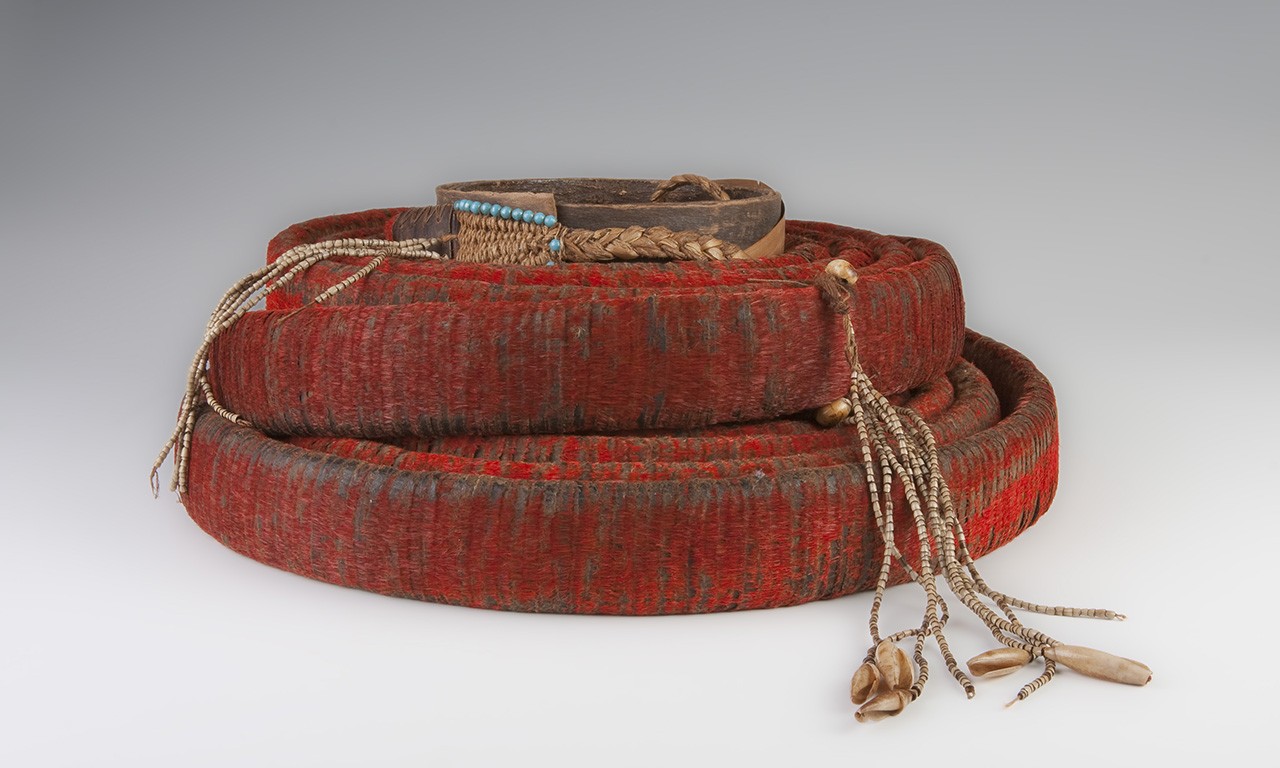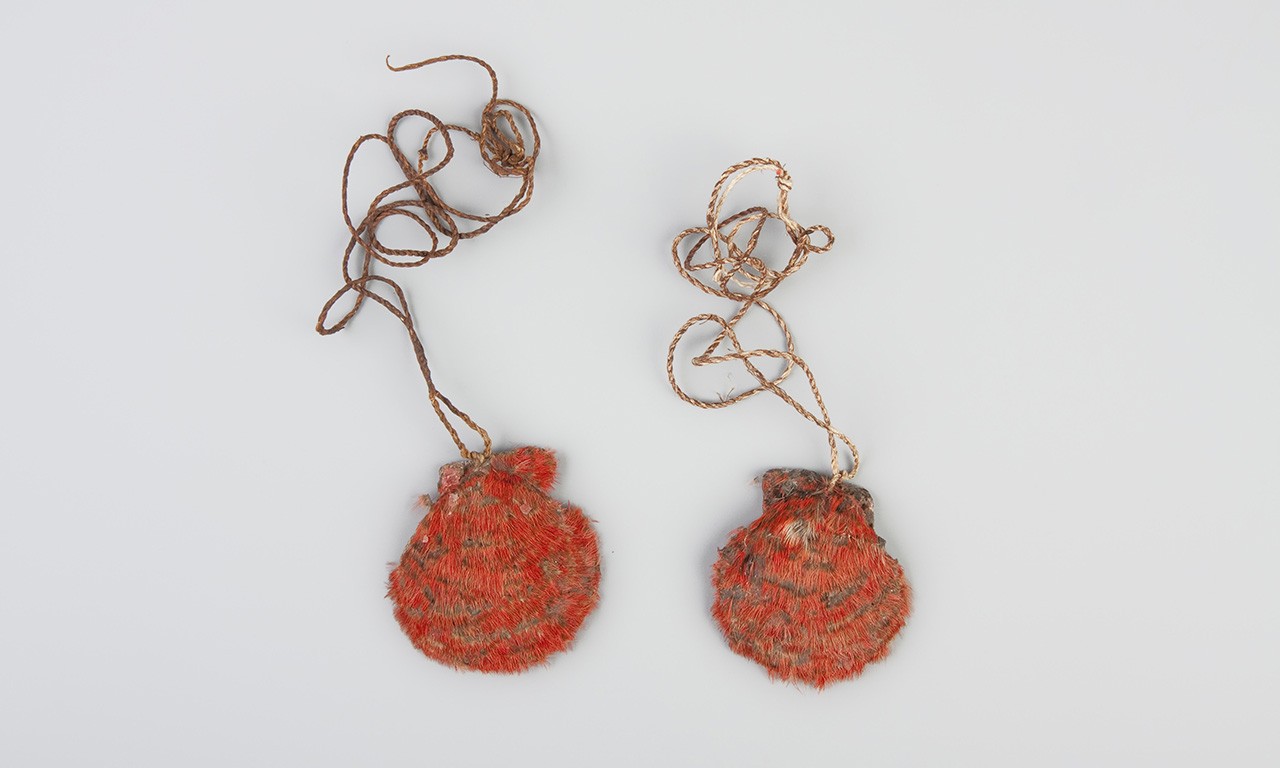 |
Feathered Currency Roll (Tevau), late 19th-mid 20th Century
Santa Cruz Islands, Temotu Province, Solomon Islands, Melanesia
Feather, bark, shell, fiber, resin and bead; 6 x 15 5/8 x 16 3/4 in.
2001.74.14
Gift of Mr. William Moran |
Red the Feather that Coils
With the Bowers Museum’s recently opened Dimensions of Form: Tamayo and Mixografía, many visitors will have seen Tamayo’s dramatic depiction of the pre-Hispanic plumed serpent god, Quetzalcoatl; his sleek body contorted into two large coils, the oft-stone-faced deity appears to be caught in a moment of surprise. While feathered beings that can coil around themselves may not be of this earth, far across the Pacific Ocean, a very different feathered creation was spooled in an almost identical way. This post examines the tevau feathered currency rolls of the Solomon Islands, looking at their creation, usage in exchange, dives briefly into the larger context of their usage.
 |
| Postage stamps from the Solomon Islands from 1990-2015 featuring Myzomela cardinalis. |
Collaboration: The Process
Three separate experts are involved in the crafting of the largest currency pieces. All the red-feathered currency pieces from the Solomon Islands, including both the shell and hair pin currencies are made from a species of red-feathered honeyeater bird (Myzomela cardinalis). The birds are hunted by coating branches in either a nut paste or sap adhesive similar to bird-lime. A lure, baited with a living or dead decoy bird, was then placed nearby. When the birds land on the coated branches they are trapped, and men collect their bright red feathers and then release them back into the wild. These hunters sell their feathers to craftsmen who use them to make small patches of feathers, alternatively called plates, scales or lendu in Santa Cruz Island vernacular. Lendu are made from a base of grey Pacific pigeon feathers and a paste made from the fruit of the paper mulberry tree is used to glue on the red honeyeater feathers.
On a Roll
Though both the gathering of feathers and the creation of lendu required specialized knowledge, the weaving of the tevau was certainly the most complex part of their creation. Over the course of the 20th Century the number of master craftsmen capable of creating these coils dwindled from a little over twenty to none. When they were made, the coils were begun by tying two thick, parallel cords between a thin stick and usually a tree or stump. The distance between the two chords was set by using a small bone as a stretcher. The lendu were then tied to these two pieces of cord with thin string. It has been estimated that a single roll took between 500 and 600 hours to produce, utilizing the feathers of somewhere between 300-600 birds. This number largely depended on the length of the coil—often around 30 feet when laid flat—and the density of feathers on lendu, both of which affected the value of the currency. The makers generally work from the center of the coil outwards in one direction, alternating every so often. The ends of the coil were terminated with triangular caps made from fiber and seeds, shell, bone and hair.

 |
| The price of a wife in the Santa Cruz Islands, n.d. Taken by J.W. Beattie, Hobart Photography |
Ratio of Exchange
The value of these currency pieces was apparently more variable than early ethnographic accounts would lead one to believe. Lengthy passages explain that brides could be purchased for ten currency coils, with the quality of each twice that of the last one so that the value ratio of the first and last bands was 512:1. The reality of these exchanges was likely far more complex, though these objects certainly were used as payment for bride price as well as traded in exchange for pigs, canoes, taro root and labor. But perhaps one of the most interesting aspects of tevau is that it is a currency which depreciate over time. The most valuable pieces have the best maintained feathers and the reddest sheen, qualities which immediately deteriorate in the islands’ tropical climate. To protect the feathered currency, they were often stored indoors high above fires so that they were kept dry and relatively pest-free.

 |
Feathered Shell Currency (Nyarpo), 20th Century
Santa Cruz Islands, Temotu Province, Solomon Islands, Melanesia
Shell, feather, fiber and resin; 6 7/8 x 2 3/8 x 3/4 and 5 x 2 1/8 x 3/4 in.
2003.7.13-.14
Purchased with funds provided by the Jordan Community Trust |
Shell Now, Feathers Depreciate
Up until the introduction of large centrally controlled monetary systems, most pieces of exchange had one thing in common: their longevity. Often made of metal whenever possible or—throughout much of Oceania—made with shell which is a similarly long half-lived medium, these pieces would certainly outlast the generous 150-year maximum lifespan of the tevau described by Santa Cruz Islanders. There is some evidence, based on interviews with islanders that feather currency had been adopted within the past few centuries, with one author positing that the usage had evolved out of the ornamented belts seen throughout much of Melanesia less than 100 years before their first documented appearance in the 19th Century. Shells were used as a lower denomination currency concurrently with other non-shell feather currencies, with some examples like the above feathered in a manner consistent with tevau.
Text and images may be under copyright. Please contact Collection Department for permission to use. References are available on request. Information subject to change upon further research.






Comments